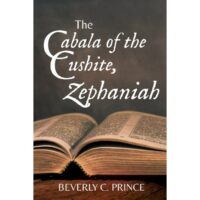Title: The Cabala of the Cushite, Zephaniah
Author: Beverly C. Prince
Publisher: Bookside Press
ASIN: B0B1P9JTD4
Pages: 502
Genre: Spiritual Education
Reviewed by: David Allen
Hollywood Book Reviews
Next time you see some Tarot cards, please take note. These strange symbols The Fool, The Magician, The Empress, etc. are much more than cheap parlor tricks. In fact, they are much more than a device for fortune telling. The Tarot is a set of symbols that supposedly represent the mythical storehouse of the unconscious; the Tarot can also be applied to the further understanding of the past, present, and the future hence, their use in divination.
Some have speculated that these minor and major ‘arcana’ are distillations of esoteric wisdom, embodied pictorially in order to protect sages, alchemists and wizards from the prying eyes of the historical Inquisition. Likewise with the Cabala (also spelled ‘Kabbalah’, ‘Qabalah.’) The Cabala was popularized in recent decades by seekers after Truth and Light. Pop singer Madonna’s involvement with Cabala gave further impetus to widespread interest in this mystical system. Theories abound as to the actual origin of this mystical system: some claim Cabala originated with the ancient Hebrews i.e., thousands of years ago; another theory has it that the mystical system embodied in the Cabala was actually a series of love letters from medieval Rabbi Moses de Leon to his sweetheart. Medieval France and the Aramaic language are other contested sources of this fascinating set of beliefs.
Interest in Cabala and Tarot, along with ‘gematria’ numerology, based on scripture emerged in late 19th century and early 20th century America in a big way. Occultists in the United States and Europe too many to list here) incorporated these in systems of ‘white magic’, ‘esoteric science’, Theosophy, and osicrucianism. It may be no accident that these practices trance, ceremonial ritual, invocation of deities and demons were termed ‘white’ magic. Fact is, Western approaches to ritual magic were culturally freighted and less than diverse. Cultural diversity appeared mostly in mention of Yoruba and the African-derived practice of Voodoun. Only recently have scholars and practitioners from other cultural groups jumped on the occult bandwagon.
Which is exactly where The Cabala of the Cushite, Zephaniah fits in. This book, part a scholarly work, part a work of the imagination, addresses this cultural schism, making for an intense and heady read, bringing the best of all worlds on this plane and beyond together.
Zephaniah identifies himself as the Biblical prophet of the same name. His travels, trials and tribulations take him between ten towns, each connected to the others by a series of 22 paths. There are ten ‘sephiroth’ or stations on the Cabalistic Tree of Life’; 22 paths, each identified by a different letter of the Hebrew alphabet and Tarot card, run between these. Zephaniah’s adventures are hortatory, exciting, and revealing. Part of what is revealed is pure cultural remediation – we are all brothers and sisters under the skin, and our belief systems, our collective unconscious, overlap like girders on a mighty bridge.
The book is a much-needed remedy, and a very welcome addition to the spiritual and cultural diversity bookshelves. In this cautionary epic, peoples of the world have fled to an underworld habitat where they are divided by color, technology, and culture (\sound familiar?. The appearance of Zephaniah becomes a springboard for reflection, an opportunity for community, and for the possibility of action.
The diagrams and illustrations accompanying the narrative provide clarity and explication of Zephaniah’s spiritual route. This book will turbocharge interest in transcultural psychology and mythology. It will inspire readers to pursue their own spiritual paths in the knowledge that people of any color or denomination can ‘get on the bus.’

